Broccoli with Homemade Cavatelli and Crudo Extra Virgin Olive Oil
This dish is simple, unfussy, and flexible. Maybe that is one reason why it is so good. Vibrant green broccoli and toothsome pasta are tossed with toasted pine nuts, peperoncino flakes, Parmigiano, and warm garlic-scented olive oil. And what oil this is. When I decided to write this article, it was going to be about how to make a simple dinner and the traditional pasta corta (short pasta) known as cavatelli, but once I tasted a spoonful of the Crudo Extra Virgin olive oil, my perspective shifted, and the dish ran away with the spoon.
I’ve tasted lots of olive oil. I’ve written lots about olive oil, but this monocultivar (an oil made from just one type of olive) from the province of Bari in Puglia is in a class by itself. It has won numerous awards including a Gold Medal in the New York International Olive Oil Competition and a Silver Medal in the Los Angeles International Olive Oil Competition, both in 2013. The flavorful but delicate oil is pressed from Ogliarola olives grown by the Schiralli family who have been in the oil business since 1922. The family’s oliveto (farm) near Bitetto has more than 8,000 olive trees spread over the Apulian foothills. Rocky soil, sea air and plenty of sun make for perfect growing conditions. The oil is pressed and bottled on site.
Crudo is clear, mildly spiced, and high in polyphenols, the healthful anti-oxidant compounds found in fine olive oils. With a vivid yellow-green color and an aroma of tomato leaves, parsley, and herbs, it sports distinct notes of almond. Dribbled generously over warm crostini it transformed the bread into a succulent mouthful. The scent of the warm oil entered my nostrils at the same time as the green notes filled my mouth. Then the mild pepper made its way to my throat, and some of the warm oil slid down my chin. I just had to laugh. It really was that good.
The flexible, unfussy part of this recipe comes right at the beginning because truth to tell, you don’t have to use broccoli. If you’ve got it, use green or purple cauliflower or broccoli romanesco, that cool looking green vegetable that looks like it landed from outer space. Cima di rapa would also be tasty. In Puglia, one of the areas where this pasta is found, turnip greens are often used. In early Spring when the fave come in, toss some with cavatelli, olive oil and chunks of Ricotta Salata for a satisfying and tasty meal. Dishes like this are all about local, in-season, easy and fresh.
I used broccoli because I had some left over from dinner the night before. I had blanched the broccoli florets in generously salted boiling water for about 4 minutes, then stopped the cooking by dropping the florets in ice water, a process known as shocking. However, the broccoli, or any vegetable of choice, could just as easily have been cooked right along with the cavatelli for the last few minutes of cooking time. Do what is easiest.
I have called for pignoli (pine nuts), but they are more expensive than ever this year. The Crudo Extra Virgin Olive Oil has a remarkably intoxicating scent of almonds, so feel free to substitute slivered almonds for the pignoli. Take the time to toast the nuts first, tossing them gently in a small skillet over medium heat, until they become fragrant and take on a golden color. They taste better that way.
Make this classic country dish a few times, and it will become your signature dish. Try adding a few anchovy fillets to the oil as it warms in the skillet. If you have day old country bread, blitz it in a food processor fitted with the metal knife and add ¾ cup of the finely chopped crumbs to the oil as it heats, tossing the crumbs as they gently toast, for another layer of flavor. Top the dish with breadcrumbs instead of cheese.
Many thanks to Olio2Go for sending this bottle of liquid gold out to California for me to try. Dear Reader, I can only say I hope you get your hands on some.
Broccoli with Homemade Cavatelli and Crudo Extra Virgin Olive Oil
serves 4
Cavatelli are often served with tomato sauce, and also with heavier ragus. They are a great match because the ridges on the pasta’s surface grip the sauce, and the hollow fills, delivering tasty mouthfuls with every bite. The pasta holds the olive oil just as well. It slithers over the pasta coating it and pooling between the ridges, filling the concavity with its silky, sun-drenched flavor.
As good and as enticing as this dish is with homemade cavatelli, you can also enjoy it with one of the widely available industrially produced brands. Any pasta corta, such as orecchiette, fusilli, or gemelli would work well here. Use more or less pasta, or more or less broccoli as desired. Instead of Parmigiano to finish the dish, try a favorite Pecorino (sheep’s milk cheese.) Simple country cooking like this should be an absolute pleasure and come together with a minimum of fuss and the greatest of ease. Full of flavor, it will soothe body and soul.
12 ounces to 1 pound broccoli, separated into florets, blanched, shocked and drained OR cooked along with the cavatelli
3 cloves of garlic, peeled and lightly crushed
peperoncino flakes
cup pine nuts or slivered almonds
Crudo Extra Virgin Olive Oil
Parmigiano to pass at the table
Cavatelli, 1 recipe of fresh or 3/4-1 pound dried
Bring 6 quarts of water to a rolling boil. As the water heats, drop the nuts in a small heavy-bottom skillet and lightly toast over medium heat for a few minutes, shaking the pan often. Don’t over toast or the nuts will burn and develop a distinctly unpleasant, sharp, bitter edge. Remove from the pan and set aside.
Pour ½ cup of Crudo Extra Virgin Olive Oil into a 12-inch skillet. Add the lightly crushed garlic cloves and ½ teaspoon of peperoncino flakes. Heat the oil very gently over a low flame, letting it slowly absorb the scent of the garlic and peperoncino.
Once the water has come to a boil, add ¼ cup coarse sea salt. Add the cavatelli and boil about 9 to 14 minutes. The cooking time will depend both on the size of the cavatelli and on how long they have dried. If using commercial cavatelli, cook according to the manufacturer’s directions.
About 3 minutes before the pasta is ready, increase the heat under the skillet to medium high and add the broccoli. (If cooking the broccoli with the cavatelli, add it to the boiling water about 4 minutes before the cavatelli have finished cooking.)
Increase the heat to high under the skillet. Drain the cavatelli (and broccoli, if cooked together) and carefully add to the hot skillet. The water may bubble up, so exercise caution. Add the toasted pine nuts, along with a ladle or two of pasta water. Add a few tablespoons of olive oil and more peperoncino, if desired, tossing to coat. Transfer to a serving dish or serve directly from the skillet. Pass the Parmigiano or other grating cheese.
Homemade Cavatelli
This pasta is found across Southern Italy, that sun-drenched clutch of Italian regions known collectively as the Mezzogiorno. It has more names than I have space to relate, many peculiar to the region, province, or city in which it is made and eaten. Cavatelli, cavatieddi, cazzarille, capunti and cavatuneddi, are but a few names. The dough, typically eggless, can be made from various flours (most commonly wheat) and water (either boiling, warm or cold), with salt sometimes being added. The type of flour varies from cook to cook and region to region. In parts of Puglia cavatelli are made with fava flour. Some Pugliese cooks use the region’s famous grano arso, a toasted hard wheat flour that lends a distinctive nutty flavor and dusky hue to the finished product. Many cooks use semola rimacinata, a very finely milled hard (high-protein) golden wheat flour.
I have used a combination of semola rimacinata and all-purpose 00 (doppio zero or double 00) flour, a slightly softer wheat flour that, like semola rimacinata, is very finely ground. The combination makes a dough that is easy to manipulate, yet maintains a toothy al dente texture when cooked.
The flours themselves are a joy to work with, the rich sunny yellow of the semola rimacinata providing a striking visual contrast to the stark white of the 00 flour. The flours feel cool to the touch, and the talc-fine grains run between the fingers, kicking up a fine wheaty-smelling dust that is pleasurable beyond belief.
Cavatelli can be made entirely by hand, the dough rolled into slender ropes, anywhere from about ¼ to ½ inch in diameter, cut in tiny knobs and rolled along a table using one, two, or three fingers to make the concave indentation. Sometimes a blunt ended tool known as a sferre is used to form cavatelli’s trademark hollow center. They can be larger or smaller, plain or grooved, and the little indentation more or less open.
When made using two or three fingers, the larger cavatelli are described as ‘ncatenate (chained.) Large cavatelli such as these are often used in soups along with legumes and vegetables.
Additionally, some cooks use a pettine (garganelli comb), or a gnocchi board to form the cavatelli while others use a hand-cranked machine. It seems every family, every cook, has his or her own method.
1 ½ cups 00 OR all-purpose flour
1 cup semola rimacinata
½ teaspoon fine sea salt
¾ to 1 cup lukewarm water
Extra flour to roll and form dough
To make the dough in a food processor: place the flours and sea salt in the workbowl fitted with the metal knife. Pulse briefly to blend. With the machine running, add ¾ cup lukewarm water until the dough forms small clumps. If it is too dry, add lukewarm water 1 teaspoon at a time. If it is too wet, add a bit more flour, a little at a time. Drop the dough onto a lightly floured board and knead gently for about 5 minutes until smooth and firm. Form the dough into a disk, wrap in plastic and set aside to rest 30 minutes.
To make the dough by hand: place the flours and salt in a small pile on a spianatoia (pasta board) or work counter, and stir to combine. Form a fontana (well), in the center, by hollowing out an area about the size of an orange. Slowly pour ¾ cup lukewarm water into the fontana, using a fork to integrate the flour and water, adding more water as necessary. Work the flour in slowly and combine it well to avoid creating lumps. Once the water has been added and the dough has come together in a shaggy mass, use a bench scraper to push it aside. Clean the spianatoia of any loose pieces of dough. Dust the spianatoia lightly with flour and knead the dough until it is smooth and firm, about 5 to 8 minutes. Form the dough into a disk, wrap in plastic and set aside to rest 30 minutes.
Clamp the cavatelli maker onto the spianatoia. Line 2 trays with lint-free towels and lightly dust the towels with flour.
Lightly flour the spianatoia. Unwrap the dough and roll to about ½ inch thick. Cut the dough into strips and roll into ropes just under ½ inch thick. Flour one rope well and feed it into the cavatelli machine, turning the crank to feed the pasta through. The formed cavatelli will drop from the side opposite the rollers. Toss the formed cavatelli lightly to coat with flour, and transfer them to the towel lined trays. Repeat with all the dough. Dry the cavatelli on the trays for 1to 2 hours prior to boiling.
Semola rimacinata, 00 flour and Crudo Extra Virgin Olive Oil are available online from Olio2Go and at their brick and mortar store at 8400 Hilltop Road, Suite H, Fairfax, VA 22031.
Hand-cranked cavatelli makers are available from Artisanal Pasta Tools in Napa, California.
Click here to see Terry Mirri of Artisanal Pasta Tools demonstrate the use of the hand-cranked cavatelli maker.
Disclosure: I received the Crudo Extra Virgin Olive Oil for review. I only recommend products or services I use personally and believe will be good for my readers. I otherwise have no affiliation with any product, manufacturer, or site mentioned in this article.
Note: You can click on any picture for a larger image, and to see a slide show!
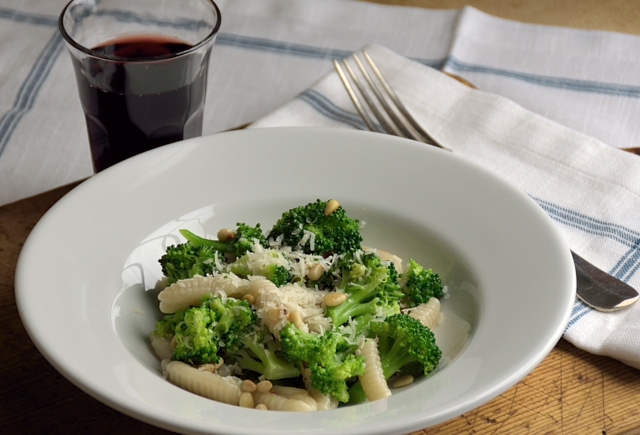



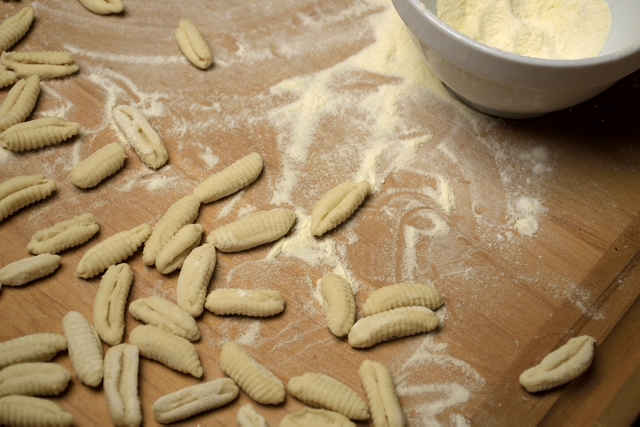
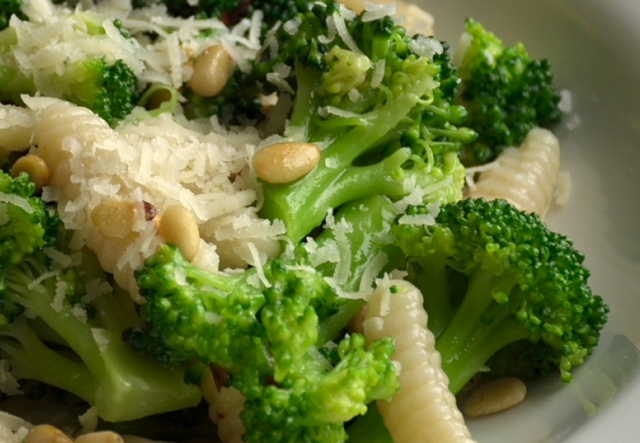
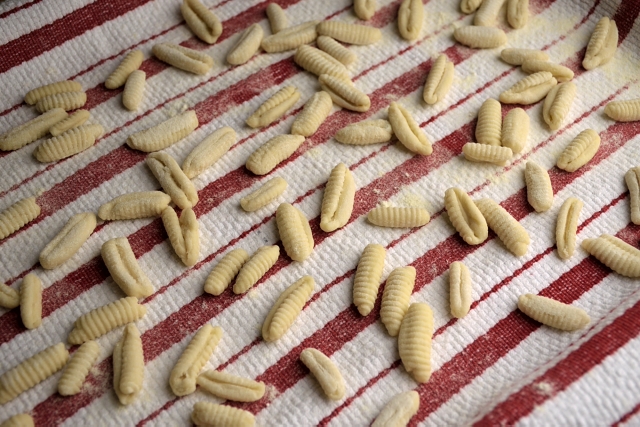

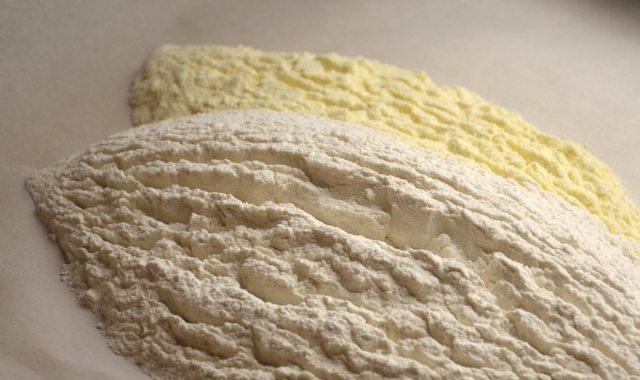

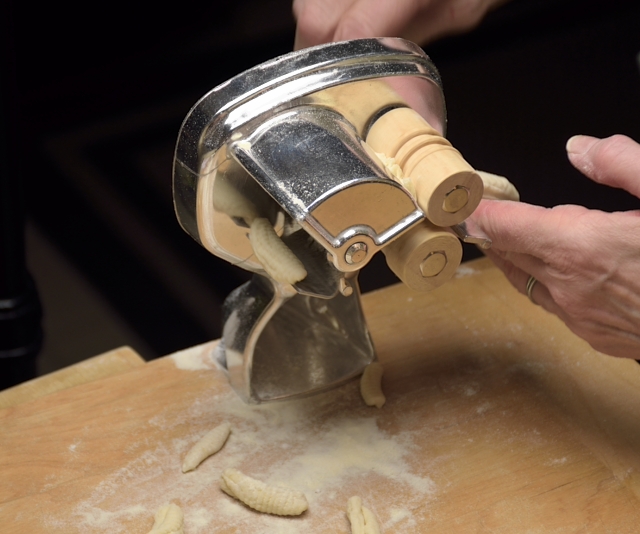
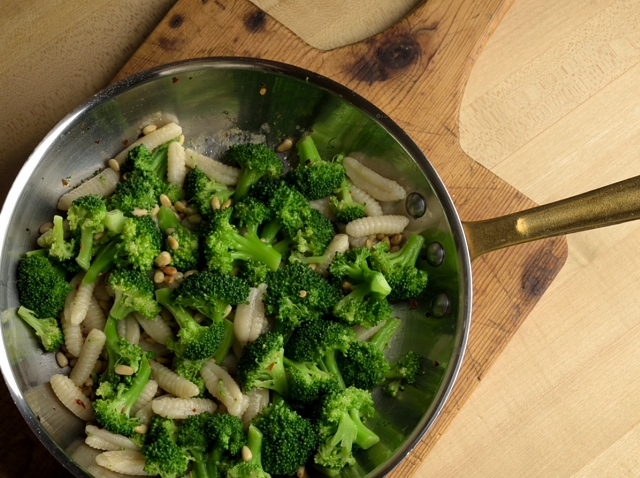

Sunday, January 26th 2014 at 12:24 pm |
Ciao Adri ! e’ un piacere conoscerti, hai un bellissimo blog ! Mi piace molto questa ricetta così accuratamente descritta e con delle belle foto ! Complimenti ! e non sai cosa darei per avere quella macchinetta per fare i cavatelli !
Sunday, January 26th 2014 at 3:29 pm |
Ciao Rosella,
Grazie per la tua visita al mio blog e per le tue gentilissime parole. E davero, adoro questa macchinetta!
Sunday, January 26th 2014 at 1:50 pm |
Ciao Adri. Have you tried sprouting broccoli? Some farmers here grow them and I get them at my winter CSA. They are purplish, cook fast and are great with pasta. Pasta names in Italy are complicated to trace. Beyond a certain point, it’s the shape that counts and cavatelli’s is a great one. I particularly like the combination with vegetables: the result is light and nourishing. I have never seen a hand-cranked cavatelli maker: it looks cute.
Sunday, January 26th 2014 at 3:37 pm |
Welcome Simona,
No. I have never tried sprouting broccoli-it is new to me! I will have to find some. Thank you for the suggestion. You are so right about the pasta names in Italy; even the scholars of the Italian culinary tradition have been known to differ. About this machine – I love it! At one point here in America, they could be found in almost every Italian-American kitchen. They fell from favor in the mid and late 20th century, only to return with the renewed interest in traditional Italian-American and Italian cuisine. Some cooks are purchasing them new or on sites such as eBay. My friend Terry Mirri, of Artisanal Pasta Tools sells them also. Still others are finding una macchinetta in the attic of their grandparents. Everything old is new again.
Monday, January 27th 2014 at 11:31 am |
I love the flexibility of this dish and using whatever is seasonal. That olive oil sounds incredible. I didn’t know there were Olive Oil competitions! I’m going to look into educating myself a little more on using better olive oils.
Monday, January 27th 2014 at 7:32 pm |
Hi Pam,
Yes, there are many competitions around the world. And there is so much to know and learn about olive oil. Check out the Olio2G0 site. There is lots of great info there! Thanks for stopping by!
Wednesday, January 29th 2014 at 4:21 am |
I have made this dish much in the same way using the bitter broccoli rabe. It makes a wonderful, satisfying meal. Beautiful tutorial on the cavatelli making. You have the best kitchen tools!
And, your description of the olive oil is positively heavenly.
Wednesday, January 29th 2014 at 5:14 am |
Hi Nancy,
This dish with broccoli rabe is a classic of the Italian canon – and so wonderful. Thank you for the kind words, and I hope you get a chance to sample this oil. It really is delicious! Alla prossima!
Thursday, January 30th 2014 at 11:31 am |
Magnificent! This healthy, scrumptious and refined pasta dish is irresistible.
Cheers,
Rosa
Thursday, January 30th 2014 at 2:54 pm |
Thank you, Rosa!
Friday, January 31st 2014 at 7:54 pm |
This looks so delicious and you’ve taken so much care to show us how it’s done! Thank you! I’ve never heard of this type of pasta before and it looks like you created it to perfection. A true labor of love.
Friday, January 31st 2014 at 9:27 pm |
Hi Marilyn,
I’m glad you enjoyed this-it’s a classic in our home! Thanks for stopping by.
Sunday, February 2nd 2014 at 8:19 am |
I normally make this with orecchiette, but I’d switch to cavatelli any day, if I could make them as regular and perfectly shaped as these ones:)
Sunday, February 2nd 2014 at 10:28 am |
Hi Mette,
The little machine works like a charm! Thanks for visiting!
Sunday, February 2nd 2014 at 1:37 pm |
Ci piacciono i broccoli, e che bella la tua pasta fresca! Invidiamo molto la tua macchinetta
Sunday, February 2nd 2014 at 8:47 pm |
Benvenuta!
Anch’io adoro la machinetta! Grazie per aver visitato il mio sito!
Thursday, February 6th 2014 at 8:24 am |
Wonderful instructions for making the pasta – as well as gorgeous photos! And the sauce looks marvelous – I love very simple sauces like this, especially with homemade pasta, so that they flavor of the pasta shines. A truly lovely dish!
Thursday, February 6th 2014 at 8:52 am |
Hi Donalyn,
These simple ones are my favorites. I am glad you enjoyed this!
Thursday, February 6th 2014 at 11:20 am |
Dear Adri, I am in total awe of your pasta making skills – I would love to be able to make pasta like this. The cavatelli have a beautiful shape and they look so pretty with the broccoli. Homemade pasta with vegetables, premium olive oil, a good sprinkling of parmigiano reggiano and some pine nuts – what an incredibly delicious treat!
Thursday, February 6th 2014 at 5:15 pm |
Hi Andrea,
Thanks for the kind words. I have to say, though, that with all of your baking skills and cooking technique, this would be a snap for you. ALso, dishes like this, simple pasta creations with fresh vegetables will fit right in with your current vegetable project!
Tuesday, February 11th 2014 at 2:09 pm |
My sweet mother-in-law used to make this dish. I haven’t had it since she passed away. Thank you for bringing back memories of her delicious cooking.
Tuesday, February 11th 2014 at 3:06 pm |
Hi Karen,
Oh my! I have been so touched by the family memories this one evokes. Thanks for sharing yours!
Sunday, February 16th 2014 at 1:30 pm |
This looks wonderful, and I love the addition of pinoli! I might be tempted to add some sausage…
Sunday, February 16th 2014 at 5:06 pm |
Hello you two!
Ooh, sausage sounds great to me! Thanks for stopping by, and buona domenica!